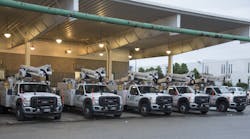It’s business as usual in the Transportation Dept. for Louisville Gas & Electric Co. (LG&E) and Kentucky Utilities Co. (KU)—and for good reason. “Our consolidated fleet, lean transportation management team, and outsourced maintenance programs are generating cost savings,” said Jeffrey Schneider, fleet contract manager for the LG&E and KU operations.
LG&E and KU, part of the PPL Corporation family of companies, are regulated sister utilities that serve nearly 1.3 million electric and natural gas customers. LG&E operates in Louisville and 16 surrounding counties, and KU serves customers within 77 Kentucky counties and five counties in Virginia.
While the LG&E and KU fleets operate independently, the three-person department overseeing their operations provides opportunities for streamlining equipment acquisition, standardizing specifications, and providing maintenance and fuel-purchasing services.
In total, the combined fleets include more than 1,300 licensed vehicles and almost 1,200 pieces of equipment. Vehicles supplied mainly by Ford and Freightliner range from sedans to 100-ft. bucket trucks.
“This year, our main focus has been vehicle contracts,” Schneider related. “We have heavy- and light-duty fleet committees made up of representatives from each of our electric and gas business lines that develop standards and, in conjunction with our department, decide the type of vehicles that will be available.
“Our goal has been to standardize light- and heavy-duty vehicles to keep costs low for user departments,” he continued. “We can’t manage utilization, but we can give our businesses as much information as possible to make effective decisions.”
LG&E and KU use benchmarking data, supplied by Utilimarc, that compares the fleet’s performance internally and against other similar investor-owned utilities. Also in place from the supplier is a telematics platform that generates real-time updates on a range of vehicle, operational and safety items.
“We ran a trial of the Utilimarc telematics solution on a portion of our light- duty vehicles and realized a decrease in excess mileage of 18%,” Schneider reported. “The resulting fuel savings led to the decision to adopt the technology for all of our light-duty vehicles and to begin evaluating the use of this technology for our heavy-duty fleet as well.”
Other data sources used by the utilities include daily downloads of fuel transactions and odometer readings from fuel card provider Fleet One. The information is then uploaded to the fleet’s AssetWorks software, which captures and analyzes repair order, parts and labor information for all vehicles and equipment.
Monthly reports and quarterly scorecards from Serco, managed fleet maintenance provider for LG&E and KU, complement the data. “They provide a number of key process indicators that we use to measure maintenance effectiveness and evaluate specifications,” Schneider said.
All vehicles in the LG&E and KU fleets are leased from local dealers and from Altec. This is a long-standing practice driven in part by accounting practices.
Currently, the utilities are evaluating the new standards from the Financial Accounting Standards Board (FASB) that will, beginning in 2019, require assets leased for more than 12 months under finance or operating leases to be recognized on balance sheets.
“We’re working with our accounting team to create lease models, but the new FASB rules will not likely change our practices,” Schneider stated. “Overall, leasing fits with our goal of being a lean, efficient operation that provides cost-effective fleet services for our businesses and their customers.”



